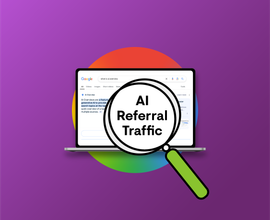Content Creation: How to Create Great Web Content
How do you tackle content creation? Follow this expert content creation process from ideation all the way through publishing to make content consumers want.
Content creation is the single most time-consuming responsibility for today’s content marketers. When you break down our day-to-day workflow, creating great content is our chief responsibility and the best way for us to engage with our audience and influence revenue. Not to mention, that’s how we earn our keep.
What is content creation?
Content creation, by definition, is the process of identifying a new topic you want to write about, deciding which form you want the content to take, formalizing your strategy (keywordKeyword
A keyword is what users write into a search engine when they want to find something specific.
Learn more or otherwise), and then actually producing it.
In addition, most content creation processes involve thorough rounds of edits with other stakeholders before content is ready to be published.
Because content can take many forms—blog posts, videos, eBooks, Tweets, infographics, and advertisements, to name a few—the content creation process is nuanced and not always as simple as it might seem, especially for beginners. But doing it well can truly impact your business. In fact, recent research proves that creating quality educational content makes customers 131% more likely to buy from your business.
Creating great content starts with a well-established process, but how can beginners get started if they don’t have a built-out process yet? We’ll walk you through the content creation process from start to finish and demonstrate how creating great content can help your audiences and customers find solutions and answers to their problems. So, where do we start?
What is a content creator?
Before we dive into the content creation process, let’s start with the basics, like the content creator definition. A content creator refers to someone who is responsible for the ideation, creation, and distribution of content that connects a brand to its target audience. The goal of content creators is to create appealing and engaging content that captures the attention of users to drive website traffic, conversions, and interactions with your brand on external platforms like social. It can be informational content, but it doesn’t have to be. It can also serve to entertain in order to increase brand awareness, for example.
Digital content creators produce content across any platform or channel. Having dedicated content creators is a must for any enterprise organization. These are the content marketers that will help bring ideas to life through quality content that provides the highest possibility of ranking in SERP and increasing the number of visitors to your site.

Content ideation
Content ideas can come from a variety of places both from within your content team, from your customers, from other stakeholders in your company, from new data, or from something that inspires you. Depending on the goal of the piece of content, deciding the correct angle you should take on a specific topic can prove challenging.
For example, if you’re tasked with creating content that highlights a new product feature, you may have a baseline idea of what you need to produce. But if your task is broader, for example, writing a piece of early-stage content that will drive organic traffic to your website, then you may need to investigate other methods of coming up with content ideas. Here are a few methods we know will help get your creative juices flowing and help you find innovative and effective approaches to potential pieces of content.
How to generate content ideas
- Find opportunities through keyword research. Keyword research is a fantastic way to discover how your audience is talking about a topic. In addition, keyword research can help you discover new opportunities for content that you may not have considered on your own. You can use keyword monthly search volume (MSV) to estimate the amount of organic traffic you may receive if you eventually begin to rank for the terms you choose to write about.
- Solicit customer feedback. Asking your customers may sound like a simple way to get an idea, but often, there are unanswered questions they have about your product or your space that you can answer. Creating content around those questions will have a direct and meaningful effect on your existing customers.
- Put yourself in your audience’s shoes. As a marketer, your first responsibility is to understand your customer. So, when you’re looking for new ideas, think about what your customer might find engaging, interesting, or helpful. Then, explore how those ideas could work with your content strategy. You can check out sites like Quora to find out what topics people are asking about in your areas of expertise.
- Brainstorm with larger groups in your org. Your organization-wide knowledge is a powerful tool to utilize when coming up with new content ideas. For example, your customer support team has a lot of insight into the day-to-day problems your customers have. Your sales team has a wealth of knowledge about which solutions potential customers need from you or want to hear the most about. Tapping other groups in your org will help identify content ideas that speak to your customers’ (and potential customers’) needs.
- Investigate what your competition is writing about. As a content creator, you should always be aware of the topics your named and unnamed competitors are writing about in your space. Understanding how your competitors approach a topic will help you differentiate your brand’s voice, approach, and content from theirs, identify gaps in their content strategy, and help your content stand out in the sales process.
Once you’ve finished the ideation phase and know which topic you want to write about, the next step is to plan and outline what you’re going to create.
Content planning
The first step in planning your piece of content is to decide what form you want it to take. Some ideas will be stronger if they are represented visually and could warrant an infographic or video. Other pieces of content may be best suited for plaintext. For those, a blog post, article, or eBook might be the best form.
You can gain a lot of insight by investigating which types of content have already been created around your topic. For example, type your topic idea (or keyword) into Google and see what kind of content comes up on page one. Are there videos or other special result types? Do the URLs link back to infographics? Do images appear in the SERP? Knowing which types of content already exist around your topic should help inform your decision about what type of content to make.
The next step is to decide on the scale of your content project. If your content idea is specific and limited, you may only need one blog post, video, or article to properly address the topic.
But if you’re approaching a large topic, especially something central to your business’s value proposition or area of expertise, you may need to create multiple pieces of content around this one idea. Successful content creators will decide exactly what their finished project will look like before they even start writing or creating.
For all our advice about how to approach SEO when creating content, check out our eBook: SEO 101 for the Content Marketer.
Questions to consider when planning content
- What persona am I targeting with this piece of content?
- What stage of the buyer’s journey will this piece of content speak to?
- How much time and money can I invest into creating this piece of content?
- What additional assistance or resources will I need (a designer to create an infographic, a video producer to film a script, etc.) to execute my vision?
- Is the content I’m creating timely? Or is this piece of content evergreen?
- How does this piece of content fit into the grander scheme of my content strategy?
- Which audiences or groups of customers will this content help?
- Who in my organization will this piece of content help?
Once you have your plan in place, you can start creating your content.
Content creation
Ah, finally time to create your content. This part you’re already a pro at. Utilize the plans you’ve made and the ideation you’ve done to produce a phenomenal finished product.
If you’ve set up steps 1 and 2 effectively, you should have everything you need to create amazing content.
But, as you write, film, design, or produce, keep in mind that content creation is a living, breathing process. If you notice something is wrong with the angle you decided to take or the content format you decided on, don’t be afraid to take a step back. This process should be fluid and may need adjustment as you gain new information about your customers and audience.
Content creation for SEO
Content creation and content creation for SEO are exactly the same, and your processes should have the same focus. In fact, if you’re creating content with the sole goal of performing well on SERPs, you’re doing a disservice to your site and, more importantly, your audience. If you create content to satisfy your users’ needs, it’s good for search engines because the strength, relevancy, and value of content is the most critical ranking factorRanking Factor
The term “Ranking Factors” describes the criteria applied by search engines when evaluating web pages in order to compile the rankings of their search results. Ranking factors can relate to a website’s content, technical implementation, user signals, backlink profile or any other features the search engine considers relevant. Understanding ranking factors is a prerequisite for effective search engine optimization.
Learn more when it comes to SEO. Essentially, create content that is helpful to your target audience, and that content will have a good chance of ranking well on SERPs.
Post publish tasks
Once publish day finally arrives and you’ve released your content out into the wide, wide world, take a long, deep breath. But don’t forget that the content creation journey, from ideation to publishing, is ongoing. A good content strategy has a solid creation process in place, as well as a promotion plan for both pre-and post-release. Your job as a content marketer is to see every piece of content along its full journey.
Content promotion
Now that your content is published, it can be surfaced on Google, and readers can finally get their eyes on it. But generally speaking, in order to drive significant and relevant organic traffic to your content, you’ll need to promote that content. Take some time to think through the best ways to get your content in front of the users you’re trying to reach. Is a simple social media strategy with posts on LinkedIn and X enough to promote this content? Or would a series of emails help to show its importance and relevance to your audience? Maybe there’s an opportunity to host a webinar or a discussion with a thought leader based on the content.
There’s no right way to promote your content, and the best channel will change depending on the content, your target audience, and your specific goals, so it’s critical to brainstorm and decide on the best course for a given piece.
Content monitoring
A finished piece of content isn’t necessarily a perfect piece of content. In fact, every piece of content can probably use some kind of improvement. It just takes time for those areas of opportunity to reveal themselves. After you publish your content, keep an eye on its performance using Google Search ConsoleGoogle Search Console
The Google Search Console is a free web analysis tool offered by Google.
Learn more and your rank-tracking platform. The Conductor platform gives insight into how your content is performing on search engines, including where it ranks, how much organic traffic it’s driving, and where you can improve. This is valuable insight that clues you into how you can provide stronger content to your audience and the potential impact an optimization will have.
Content monitoring isn’t reserved for recently published content either. There are dozens, maybe even hundreds, of opportunities for you to improve the quality and impact of your content. You can uncover those opportunities with a content audit. A content audit shows you what content on your site is driving traffic and which isn’t so that you understand what your most impactful content is and where to focus your optimization efforts. An audit also uncovers gaps in your content—topics that your audience probably has questions about, but you don’t currently speak to—that you can fill with a net new piece.
It’s best practice to thoroughly audit your content at least twice a year, perhaps even quarterly, depending on the amount of content you have.
Each piece of content you create is an experiment. Through proper monitoring and measurement of its performance, you will be able to tell what works for you and your organization. Use that knowledge to inform your efforts when you start the creation process anew for your next piece of content. By establishing a set list of KPIs and measuring your content ROI, you’ll be able to prove the value of your content efforts and gain additional buy-in for future initiatives.
Content creation in review
Ultimately, creating content can be as easy as putting a pen to paper or simply starting to type on your laptop. However, creating strong and valuable content that drives relevant traffic to your site is a lot more complicated. Creating valuable content takes hours worth of planning and research to make sure it’s speaking to the topics and answering the questions that your audience is interested in. Once it’s published, you also need to follow through and monitor the content to make sure it’s driving the results you expected. From ideation to publishing to monitoring and optimization, the content creation cycle never ends.








